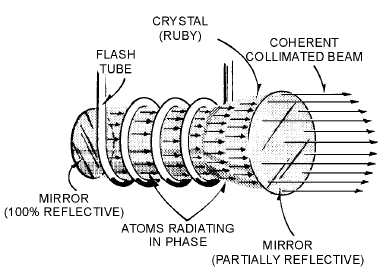5-18
Figure 5-18.—Simple laser.
COMMUNICATIONS APPLICATIONS
High-energy lasers have very small power losses. As a result, a laser with a 2- or 3-inch initial beam
can be used to communicate directly with a distant planet. However, from a communications standpoint,
they do have some drawbacks. While laser energy is capable of being formed into a very narrow beam, it
is still subject to the same difficulties as any other form of light transmission. Fog and other adverse
weather conditions can absorb the light. Small atmospheric temperature variations can cause deflection
and scattering. An optical waveguide was designed to help overcome this problem. It consists of a thin
dielectric fiber clothed by another dielectric coating several wavelengths thick. It has been successfully
used to move the beam over considerable distances and around bends. The use of optical waveguides is
known as FIBER OPTICS. A number of fibers can be paralleled to reduce the attenuation through the
waveguide. This technique has resulted in an inexpensive telephone system with a bandwidth greater than
that of previous methods. Researchers are attempting to develop a laser that will operate in the blue-green
portion of the visible spectrum. Water offers little attenuation to the blue-green band of frequencies.
Because of this, blue-green communications lasers could possibly penetrate the ocean to great depths.
This could give us a very secure undersea communications link.
Q10. Lasers operate in what portion of the frequency spectrum?
Q11. What are the two types of lasers?
Q12. What are the effects of adverse weather on the laser beam?

